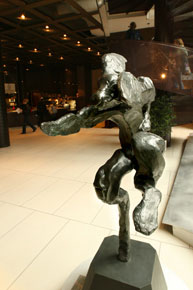Unique library for a unique school
Unique library for a unique school McGill University
User Tools (skip):
Unique library for a unique school
New students entering McGill's Gelber Law Library for the first time may be curious about the large statue of a hare that greets them in the lobby, standing upright and seemingly full of purpose. The Nijinski Hare, as he is known, is one of many pieces of art that add a distinct flair to the facility. That particular item, a former resident of the Montreal Museum of Fine Arts, is a loan from Nahum Gelber, a law alumnus who you may have guessed was instrumental in making the library a reality.

In the Nahum Gelber Law Library, the Nijinski Hare looks busy as always.
Owen Egan
The library opened its doors in 1998, rescuing scores of students and faculty from the previous library, often described as overcrowded and stuffy. Designed by one of Canada's most influential architects, Dan Hanganu, the Gelber Library is a bright, beautiful, contemporary building. It is an integral part of the law faculty and of its program as well. Every law student must follow two years of legal methodology courses, the research section of which is taught by a librarian. This way, every student is provided with an opportunity to hone their skills in what John Hobbins, law librarian, terms "information literacy" — the ability to find information in the electronic world. (Hobbins notes that required courses make for a captive audience.)
Without taking anything away from the artwork or research potential, the greatest benefit to users of the Gelber Library is undoubtedly its impressive collection, which makes it, for Hobbins, "unlike any other Canadian academic law library." It is a collection based on a policy developed by the librarians that reflects the unique nature of the law school it serves.
In 1998, McGill's Faculty of Law adopted what is known as a trans-systemic approach, whereby both common law and the civil law are studied together, with an emphasis placed on legal traditions, comparative law and the internationalization of law. The library had to suit this reality. "Other libraries offer professional training for a particular jurisdiction — we don't really do that," explained Hobbins, adding, "We tend to look at law as an academic discipline rather than as professional training for the bar." That attitude echoes the underlying philosophy of the law school.
The Gelber Library spends a larger portion of its budget than most law libraries on books and monographs, as opposed to "continuations" — journals, serials, periodicals. In so doing, it supports research (rather than training) and intensive study that is international in scope. When choosing additions to the comparative foreign collection, for example, Hobbins refers to the FIGS rule — French, Italian, German, Spanish — representing some of the more important civil jurisdictions in the world.
The library also boasts a remarkable rare-book trove, kept in a climate-controlled room that houses the Wainwright Collection, primarily the work of early French jurists on pre-Napoleonic Civil Law, and the Canadiana collection of early Canadian, British and American titles. These collections are considered national treasures and can be viewed upon request.
The Nijinski Hare looks as if he has somewhere important and interesting he needs to be. If he is looking for something important and interesting to read, he is already in the right place.

